Advent 2024 -The Cave
Kevin Ireland
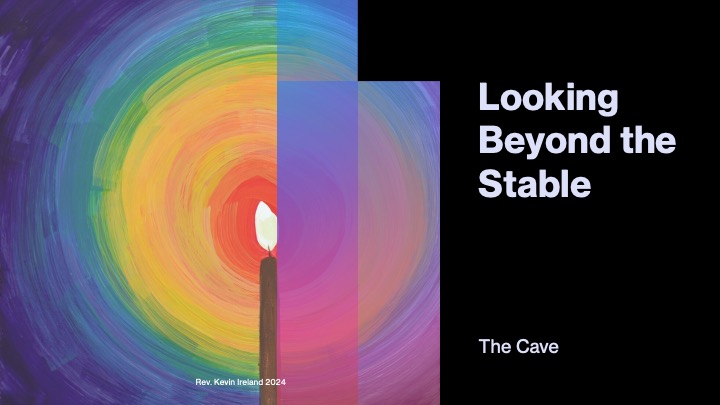
Looking Beyond the Stable
The Cave
We will continue to look at characters that we may not know in the nativity scene.
The story of Christ’s birth is bigger/broader than the birth narratives in Matthew and Luke,
One of the most popular versions came from a vision of Saint Bridget in the 14th century.
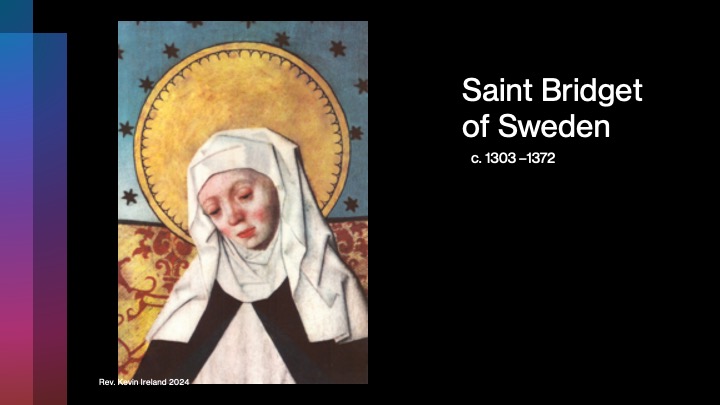
Saint Bridget of Sweden. c. 1303 –1372
• born Birgitta Birgersdotter (c. 1303 -23 July 1372) aka Birgitta of Vadstena - One of 6 patron saints of Europe.
• married Ulf Gudmarsson at age 13 – 8 children 4 girls/4 boys – 6 survived infancy .
• second daughter is honored as St. Catherine of Sweden.
• Known for her charity – especially unwed mothers and their children.
• Husband, Ulf died in 1344 – Birgitta joins the Third Order of Saint Francis,established her own religious community and order – the Bridgettines
• Supported by King Magnus IV of Sweden.
• Double monasteries with men and women in separate cloisters
• Had to give everything away to the poor (except books).
• 1350 pilgrimage to Rome w/ daughter Catherine – to obtain authorization for the new order - during the Avignon Papacy (French Popes) - sought to elevate the “moral tone” of the age fought against church corruption.

Revelations of Saint Bridget of Sweden
• The Revelations of Saint Birgitta (or Bridget) of Sweden (ca 1303-73)
• First vision – age 10 – saw Jesus hanging on the cross and asked who treated him like this. Jesus answered, “They who despise me, and spurn my love for them.”
• Revelationes coelestes (“Celestial revelations”) – translated into Latin by Matthias – made her a celebrity/controversial
• Last vision before death - Nativity
One of the most important and influential works of Swedish medieval literature.
Visions beginning in the 1340’s
First written in Swedish then translated into Latin
Final redaction made after her death by bishop of Jaén (Spain), Alfonso Pecha
8 books – oldest surviving manuscripts from between 1400 and 1425
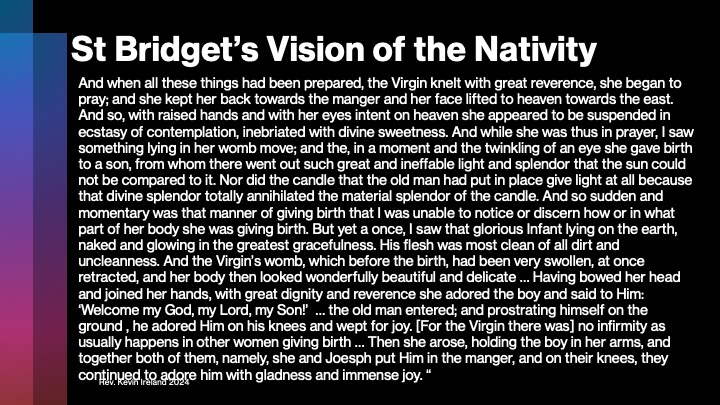
St Bridget’s Vision of the Nativity
“When I was present by the manger of the Lord in Bethlehem I beheld a Virgin of extreme beauty wrapped in a white mantle and a delicate tunic through which I perceived her virginal body. With her was an old man of great honesty and they had with them an ox and ass. These entered the cave and the man having tied them to the manger went out and brought in to the Virgin a lighted candle which having done he again went outside so as not to be present at the birth. Then the Virgin pulled off the shoes from her feet, drew off the white mantle that enveloped her, removed the veil from her head laying it beside her, thus remaining only in her tunic with her beautiful golden hair falling loosely over her shoulders. Then she produced two small linen cloths, and two woollen ones of exquisite purity and fineness which she had brought to wrap round the Child to be born, and two other small cloths to cover His head, and these too she put beside her. When all was thus prepared the Virgin knelt with great veneration in an attitude of prayer; her back was to the manger, her face uplifted to heaven and turned toward the East.
“Then, her hands extended and her eyes fixed on the sky she stood as in an ecstasy, lost in contemplation, in a rapture of divine sweetness. And while she stood thus in prayer I saw the Child in her womb move; suddenly in a moment she gave birth to her own Son from whom radiated such ineffable light and splendor that the sun was not comparable to it while the divine light totally annihilated the material light of St. Joseph's candle. So sudden and instantaneous was this birth that I could neither discover nor discern by what means it had occurred. All of a sudden I saw the glorious Infant lying on the ground naked and shining, His body pure from any soil or impurity. Then I heard the singing of the angels of miraculous sweetness and beauty. When the Virgin felt she had borne her Child immediately she worshipped Him, her hands clasped in honour and reverence saying: ‘Be welcome my God, my Lord, my Son.’
“Then, as the Child was whining and trembling from the cold and hardness of the floor where He was lying, He stretched out His arms imploring her to raise Him to the warmth of her maternal love. So His Mother took Him in her arms, pressed Him to her breast and cheek, and warmed Him with great joy and tender compassion. She then sat down on the ground laying the Child on her lap and at once began to bestow on Him much care tying up His small body, His legs and arms in long cloths, and enveloped His head in the linen garments, and when this was done the old man entered, and prostrating himself on the floor he wept for joy. And in no way was the Virgin changed by giving birth, the color of her face remained the same nor did her strength decline. She and Joseph put the Child in the manger and worshipped Him on their knees with immense joy until the arrival of the Kings who recognized the Son from the likeness to His Mother.”

• How is Bridget’s vision different from Matthew and Luke’s narratives of Christ’s birth?
• How does it change the understanding of Jesus’ birth?
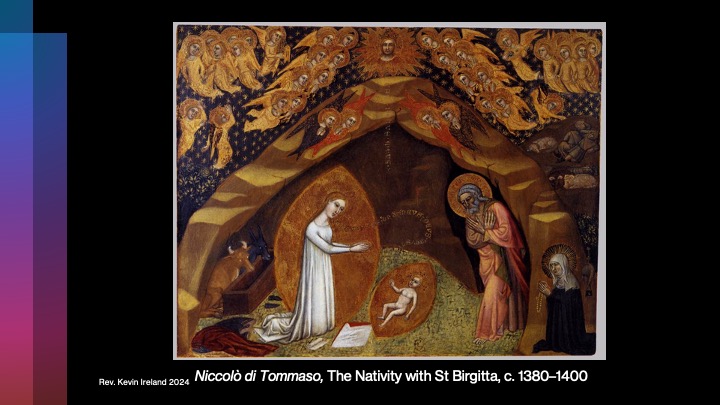
Niccolò di Tommaso, The Nativity with St Birgitta, c. 1380–1400
St. Bridget and the Vision of the Nativity – after 1372 – Tempera and gold on wood 44 x 54 cm – Pinacoteca, Vatican
One of the earliest representation of the Nativity according to the vision of St. Bridget .
Unique elements –
• Mary is a blond – only wearing a white tunic (cloak and shoes behind her), kneeling before Christ
• Christ lying on the ground – reaching up to Mary – “He extends his limbs, seeking refreshment and his mother’s favor.”
• Words coming out of her mouth (a prayer?)
• Joseph (not looking away) also worshiping
• Dark outside – but cave is brightly lit
• Angels – “sancto sancto sancto” – holy, holy, holy
• mandorla is an almond-shaped frame that surrounds a holy figure in religious art. The word "mandorla" is Italian for "almond”
• the mandorla is used to depict sacred moments that "transcend time and space",
• In Eastern Orthodox traditions mandorlas are often painted in several concentric bands of different color, which become darker in progression to the center of the mandorla. This accords with the church's use of apophatic theology, as described by Dionysius the Areopagite and others: as holiness increases, only increasing darkness can depict the luminance and brightness thereof.
In early Christian times, there was a rival religion — Mithraism (most popular monotheistic religion in Roman empire before Constantine), a sect of Zoroastrianism characterized by the worship of Mithra, The chief deity Mithras was a light deity said to have been born from a rock.
Possible that the “cave” tradition was a borrowing of Mithraic concepts, intended to make Jesus seem like the “new” deity of light.
Mithraism was a male-only cult that met in underground temples called Mithraea.

The Nativity with St Birgitta. Turino Vanni (late 14th century)
Turino Vanni – Birgitta’s Vision in Bethlehem (late 14th century) born in Rigoli, Italy – near Pisa
Commissioned by Chiara Gambacorta for San Domenico, now in Museo Nazionale di San Matteo, Pisa
God appears at the top
Shepherds look like Franciscan monks
One theory suggests that the idea wasn't original to St. Bridget, but that her vision was based on earlier images inspired by Franciscan thought
- St. Bridget was closely associated with the Franciscans.
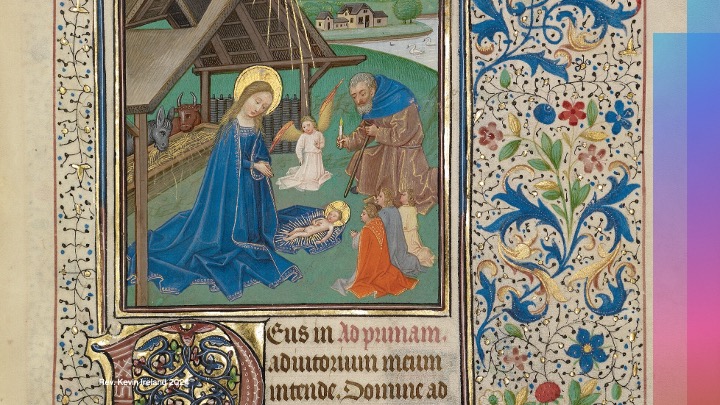
Willem Vrelant (Flemish, died 1481, active 1454 - 1481)
Date: early 1460s
Medium:
Tempera colors, gold leaf, and ink
Dimensions:
Leaf: 25.6 × 17.3 cm (10 1/16 × 6 13/16 in.)
Place:
Bruges, Belgium (Place Created) Culture: Flemish
This lavish book of hours contains over eighty miniatures, and the texts included in the book indicate that the wealthy patron was almost certainly English.
The stiff figures and unusually intense colors identify the artist as Willem Vrelant, who was an active member of the artisans' guild in Bruges.
one of the top illuminator's workshops in Bruges during the third quarter of the 1400s.
Bruges was one of the leading European centers for production of illuminated manuscripts, especially books of hours.
The person who commissioned this book may have been a member of the large community of foreign merchants living in Bruges or was perhaps a patron who lived in England.
Mary and Joseph along with four angels gather around the tiny baby Christ, who lies on a portion of the Virgin's robe.
Details such as the presence of angels and Christ lying on the ground with rays of light shining from his body come from Saint Bridget's popular account of her vision of the Nativity from the 1300s. The Nativity accompanies the prayers for Prime of the Hours of the Virgin.

Adoration of the Child
Fr Filippo Lippi (Lippo Lippi) 15th century
Fra Filippo Lippi Adoration of the Child with Saints
Born: 1406, Florence, Italy
Died: October 8, 1469 (age 63 years), Spoleto, Italy
Staatliche Museen, Berlin
Filippo Lippi O.Carm., also known as Lippo Lippi, was an Italian Renaissance painter of the Quattrocento and a Carmelite priest.
He was an early Renaissance master of a painting workshop, who taught many painters.
Sandro Botticelli and Francesco di Pesello were among his most distinguished pupils.
Cave in the background on left – in the forest on the right

The Nativity with St Birgitta
Turino Vanni (late 14th century)
Sandro Botticelli (Italian, 1444/45–1510) The Virgin Adoring the Sleeping Christ Child, ca. 1485. Tempera, oil, and gold on canvas 48 x 31 3/4 in.
It is among the greatest Renaissance paintings acquired for any museum in the UK since the Second World War.
The picture depicts the Virgin adoring her son, who lies in swaddling clothes on the ground
- a prefiguration of the dead Christ wrapped in the burial shroud.
- Behind Mary an outcrop of rock acts both as a simple shelter and a reference to the tomb.
- To the left of her, a magnificent display of thornless pink roses alludes to the Virgin's purity as the 'rose without thorns'.
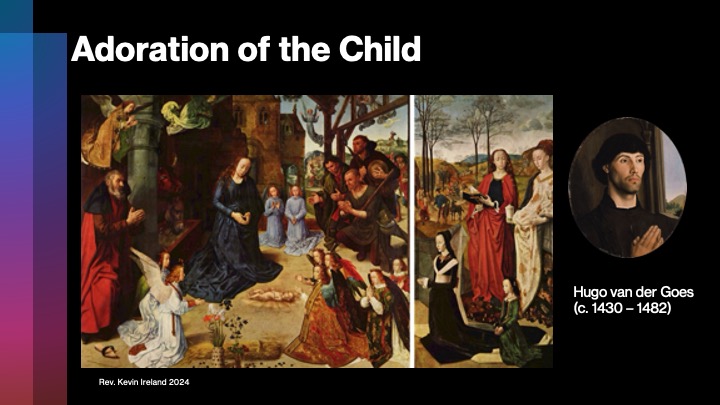
Adoration of the Child
Hugo van der Goes (c. 1430 – 1482)
Hugo van der Goes (c. 1430/1440 – 1482) was one of the most significant and original Early Netherlandish painters of the late 15th century.
Van der Goes was an important painter of altarpieces as well as portraits.
He introduced important innovations in painting through his monumental style, use of a specific color range and individualistic manner of portraiture. From 1483 onwards, the presence of his masterpiece, the Portinari Triptych, in Florence played a role in the development of realism and the use of color in Italian Renaissance art.[1]
All the angels have the same face

The Nativity at Night
Geertgen to Sint Jans – c 1490
The Nativity at Night or Night Nativity is an Early Netherlandish painting of about 1490 by Geertgen tot Sint Jans in the National Gallery, London (NG 4081).[1]
It is a panel painting in oil on oak, measuring 34 × 25.3 cm.,[1]
it has been cut down in size on all four sides.
The painting shows the Nativity of Jesus, attended by angels, and with the Annunciation to the shepherds on the hillside behind seen through the window in the center of the painting.[1]
It is a small painting presumably made for private devotional use, and Geertgen's version, with significant changes, of a lost work by Hugo van der Goes of about 1470.[2]

The Adoration of the Christ Child
Antonio Allegri (aka Correggio) c. 1526
Adoration of the Christ Child is an oil on canvas painting by the Italian Renaissance artist Correggio, dating from around 1526 and housed in the Uffizi Gallery of Florence, Italy.
Antonio Allegri, known as Correggio, named after his birth town, can be considered the leading figure of the renewal of early 16th century Emilian (Northern Italy) painting.
Having started out in the Mantuan scene, where he had the opportunity to study illusionism based on perspective and the recovery of Mantegna’s classicism, he enhanced his expertise by learning Da Vinci’s sfumato and the Venetian tonalismo techniques.
The result was a fresh, vibrant style of painting, focused on expressing the tenderness of personal relationships, and capable of winning the beholder over with its likeable spontaneous characters and precious, delicate colors.
The work was donated by Francesco I Gonzaga, duke of Mantua, to Cosimo II de' Medici of Tuscany in 1617.
The Medici exhibited it in the Uffizi Tribune, where it remained until 1634.
The original commission of the painting is however unknown, although some identify it with that mentioned by late Renaissance art biographer Giorgio Vasari and which had been brought to Reggio Emilia from Genoa by Luca Pallavicino.
Influenced by Filippino Lippi
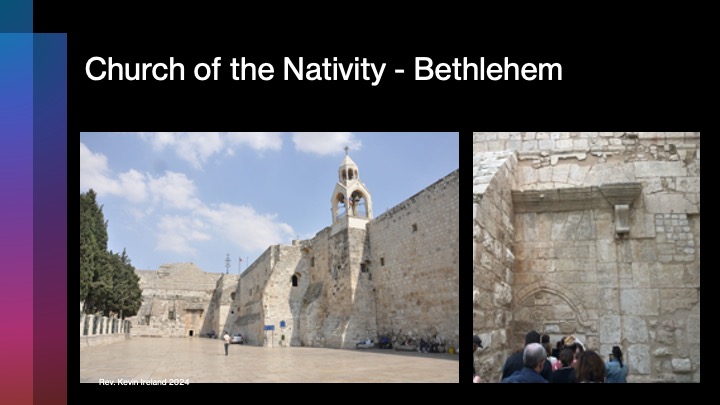
Church of the Nativity - Bethlehem
The Door of humility – at the Church of the Nativity

Church of the Nativity in Bethlehem. It is a UN World Heritage Site – the first in Palestine and Israel. Constantine the Great’s mother, Helen, was responsible for building it in 339 A.D. It was constructed over the traditional site of the birthplace of Jesus, a cave below the church.

And this is the Entrance to the Grotto of the Nativity

Rectangular in shape, the cave measures about 12 metres by 3 metres. Like the church above, it is in the possession of the Greek Orthodox Church.
The rough rock of the first Christmas has given way to marble facings and, in the words of biblical scholar E. M. Blaiklock, the cave is “hung and cluttered with all the tinsel of men’s devotions”.
On feast days the cave is lit by 48 hanging lamps. Following a serious fire in 1869, three of the walls are protected by heavy leather drapes backed with asbestos.

14 pointed star marks the place bears the words “Hic de Virgine Maria Jesus Christus natus est” (Here Jesus Christ was born to the Virgin Mary).
“So all the generations from Abraham to David were fourteen generations, and from David to the deportation to Babylon fourteen generations, and from the deportation to Babylon to the Christ fourteen generations.”
But much more than 14 generations – was Matthew wrong?
He was trying to emphasize Jesus is the Son of David. Ancient people used their alphabets to count with. (Do you remember Roman numerals from school?) So the Hebrew name for King David, dwd, has a numeric value: (d = 4) + (w = 6) + (d = 4) = the number 14!
Matthew is trying to emphasize to his Jewish readers: Jesus is the son of David (14), son of David (14), son of David (14). And now you know why there are fourteen points on the Star of Bethlehem.
Question – Why a cave (what’s the significance)
· humble
· from the earth (womb)
· caves considered sacred places
· foreshadows burial/death
· Bridgett’s vision – emphasizes light – calls us to witness to that light and bring it into the world – what Christmas is all about
^ The Cave Video ^